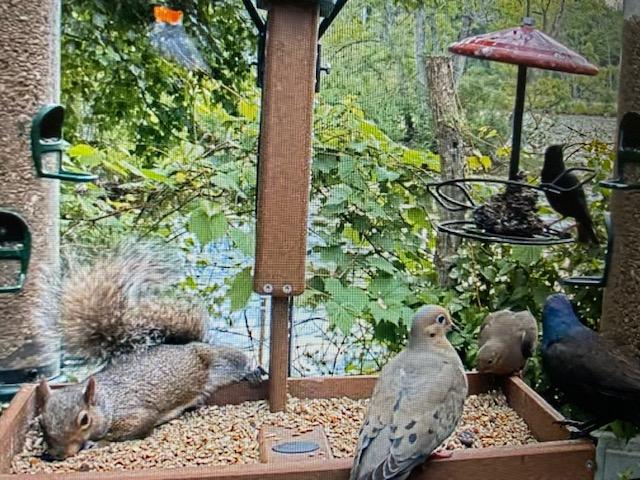The Cornell Lab Bird Academy › Discussion Groups › Joy of Birdwatching › Activities: Bird ID Practice
-
I’ve been using the Merlin app for about four months and it’s what ultimately lead me to this course. I’ve found the app quite helpful and fun to explore the birds, even to help learn the different songs. Great course so far!
-
Activity 2: interesting to identify house wren and Carolina wren. I can tell them apart if the lighting is good, but it's difficult in poor lighting. Read the description of both birds on Merlin - it says the tail of Carolina wren is as long as the body, while the tail of house wren is shorter. Nice tool for ID'ing!
-
Activity #2- red-winged blackbird, robin, downy woodpecker, all have red markings on different parts of their body. The red-winged blackbird has a red band on its wing, the robin a red chest, and the downy woodpecker has a red cap. Activity #3- birds looking for food. Not all of these were today. In the spring after the wrens hatch there is always a time when I am keeping an eye out for crows, as they steal and eat the young. This year, a pair of robins nested in the euonymous along my back fence, and the male was continually chasing out predators, and I am afraid the crows may have gotten their first clutch at least. I never saw any fledglings. And one crow captured a baby rabbit and flew away with it. The crows are very devious, and once they know where a nest is, or for that matter a group of baby rabbits, they will be back for another meal. Last fall there were various kinds of woodpeckers all over the yard looking for insects. They even tried to get insects out of old garden stakes that were still up. Lately there have been many goldfinches lighting on the Black-eyed Susans in my rain garden looking for seeds, and an unknown brown bird has been foraging for insects or seeds in the ground. I thought that I saw one of them fly away with a big worm in its mouth this morning, but was not sure. Previously I had thought that they were seed gatherers. I haven't been able to I.D. this bird. It is not new to the area- I have had them follow me around as I weed in the garden or even follow me around as I use the trimmer to trim the weeds. I think that they may be juveniles, as they are very drab in their coloring, and I cannot find them in any book. I have a Rufus hummingbird that I see almost daily feeding on various flowers around the garden- Another yearly occurrence is something I refer to as a sort of sparrow party. When the seeds from the goatsbeard are ripe, the sparrows form a group around the plants and hop upwards to grab at the seedheads. They also will do this with millet. It is quite a lovely sight to see- And of course, after I water the vegetables in the morning, the robins come out to look for worms. I may take a hike and redo this activity in an outdoor space less familiar to me. I will likely have a very different set of birds.
-
Activity #1 finding birds either outside or on bird cams and distinguishing them by their shapes only. Hairy Woodpecker, Cardinal, Common Grackle, and mourning dove on the Cornell Feeder Webcam. All have very different shapes- shapes and lengths of beaks, amount of tail feathers and lengths of tails, length of necks, roundness of heads, and overall size. Hairy woodpeckers and Cardinals are rather medium sized. I also saw a hummingbird- very tiny with long bill and short tail. Mourning doves and grackles may be nearer in size, but the roundness of the dove's body and the length of its neck, which is on the longer side of medium, and the roundness of its head, not to mention the type of beak of each are all distinguishing features. The dove's head is strikingly small in comparison to its body, and quite spherical. Although grackles have a medium sized beak it is broader and more aggressively used than the dove's, which is thin and long. The grackle body is oval, their heads are prominent, with very little neck, and their tails are medium length. The cardinal has a tuft on its head and a short, pointed but wider beak. The hairy woodpecker has a longer and pointier beak, a medium body size with a short neck, and a short tail. Also a smallish oval head.
-
I'm from Melbourne Australia, and enjoying the course so far; I hope Merlin works for Australia as it appears very useful for the beginner like me!
-
We recently had our backyard bulldozed for a redo of the yard. Left standing is a large old olive tree and a couple of other trees. The olive has a bee hive in a cavity in one of the trunks. I have been seeing a couple of crows flying into the yard and tiptoeing around the base of the tree. I wonder if they like honey? They move around to the back of the tree where I lose sight of them and then I see them quickly fly away and land on a utility wire nearby. I’m curious about what they might be doing. Is it the honey, the bees, or something else they’re after? I live in Redlands, CA 80 miles east of Los Angeles. Sarah
-
Activity 4: A bird I really liked was the blue-crowned Motmot:
 The Motmot is between the size of a sparrow and the size of a crow; it is around a foot tall. It has distinctive blue tail feathers, which end with feathers that seem almost separated from the actual tail feathers. We saw the Motmot in Carara National Park in Puntarenas, Costa Rica.
The Motmot is between the size of a sparrow and the size of a crow; it is around a foot tall. It has distinctive blue tail feathers, which end with feathers that seem almost separated from the actual tail feathers. We saw the Motmot in Carara National Park in Puntarenas, Costa Rica. -
Activity 1: I often distinguish bushtits from chickadees - they flock together - by their shape. The bushtit is somewhat smaller and has a long tail for its body. Chickadees are a big stouter. Activity 2: Robins and their close relative the varied thrush have such similar colours, but in different places. Robin red breast is a good way to tell them apart. But it's hard for me not to factor in other clues like their sound and habitat. Varied thrushes are so shy - they rarely leave the forest and they have this high, reedy call which sends shivers down my spine. I love them! Activity 3: Look for three different birds that are searching for food today. Well, it's always fund to watch crows on the seaside. They'll pick up shells and drop them, to get at their innards. And you can often find an oyster catcher - not only by their bright orange beaks but by the crows congregating around them looking for a free meal. Seagulls also scavenge and use similar tactics. They'll even eat starfish. It takes them hours to swallow one and I couldn't believe it when I first spotted a seagull with starfish legs spilling out of its beak - hilarious. Towhees are adorable - you'll hear one before you see it, because they like to thrash around in leaf litter, looking for critters. Activity 4: I guess a favorite bird would be the harlequin duck. It is smaller and sleeker than a mallard - more like a wood duck in size and shape. The male's markings are so distinctive (white spots and stripes as well as the chestnut sides), which is why they're named after clowns. They nest inshore during the summer so living on the coast as I do, I only see them between October and May/June. I look forward to their return and know exactly where to find them, in a sheltered bay. They are not wimps however. If the seas are raging, they're gamely out there surfing the waves; they plough right through them. They tend to dive repeatedly, a pattern you can see from afar, as they flip their tails up before heading down. They don't make much sound - occasionally, I will hear a high-pitched squeak. That seems to be true of the ocean-going ducks overall. While it's hard to have a favorite, I adore these guys.



-
My new favorite bird is the Black Phoebe. We only noticed it here recently, perched in the distance. At first it seemed to be just grey and we could not figure out what it was. After looking for a few days we determined it was sized between a sparrow and a crow, had a blacker head and white on it’s belly. The tail was narrow and also black. Merlin helped us make the positive ID. It will perch for a while then swoop down. There seem to be two. We are still watching to learn more about this bird.
-
Activity 1: Look for two birds (either outside or on Bird Cams) that you can tell apart just by shape. Try to identify them using Merlin or a field guide. Share your findings in the discussion. My two birds were a rock pigeon and a Glaucous-winged Gull, which I've always known as a seagull. The shapes are actually soemwhat similar between the two birds. Though the Gull is larger than the pigeon, both have large bodies and smaller heads. The gull has a long beak that is about the same size as its head. The pigeon has a short beak, smaller than its head. The gull has long legs and the pigeon short legs. Activity 4: Pick your favorite bird, and see if you can describe it using at least three of the bird ID strategies (size and shape, color pattern and markings, behavior, habitat and range, and sounds). Share your description in the discussion. My favorite bird at the moment is the red winged blackbird. This bird has a really lovely song that captured my attention. The bird is smaller than a crow and larger than a sparrow. It has a roundish body and no discernible neck. it has a short, stout beak. The ones I see on my daily walks are solid black with a red cap on its upper wings, trimmed with yellow. The two I regularly see are in the same bushes every day. Each bush is growing over the water on a lake. I've only seen them flying or perched in the bushes.
-
 I want to give a shout out to one of my favorites, the mourning dove. They are just so chill! Love to watch them strut around our deck gobbling up the millet and such that other birds drop from our hopper feeder. Or they'll just sit on the rail taking in all the flurry of action at the feeders. Nothing fazes them (except maybe another mourning dove that tries to grab their seed). And then they'll go back to the woods and start cooing away. Love their round gray medium sized bodies with the black spots (including the big round dark eyes), their big feet and stubby little legs.
Btw, CLO has a neat online page called "What Bird are you Most Like" https://cornelllabpgstore.com/what-bird-are-you-most-like-all-outcomes/. I was a great horned owl and my wife was the mourning dove, so there you go!
Very much enjoying the course that my son (with two degrees from Cornell!) got me for my birthday.
I want to give a shout out to one of my favorites, the mourning dove. They are just so chill! Love to watch them strut around our deck gobbling up the millet and such that other birds drop from our hopper feeder. Or they'll just sit on the rail taking in all the flurry of action at the feeders. Nothing fazes them (except maybe another mourning dove that tries to grab their seed). And then they'll go back to the woods and start cooing away. Love their round gray medium sized bodies with the black spots (including the big round dark eyes), their big feet and stubby little legs.
Btw, CLO has a neat online page called "What Bird are you Most Like" https://cornelllabpgstore.com/what-bird-are-you-most-like-all-outcomes/. I was a great horned owl and my wife was the mourning dove, so there you go!
Very much enjoying the course that my son (with two degrees from Cornell!) got me for my birthday. -
Oh thank you - I love them too! Their haunting sound is beautiful - when I hear the song of a ring-collared dove (our local guy), I instantly think back to amazing times in the American southwest and the lovely mourning doves.
-
-


 Activity 2. 1 is a white-breasted nuthatch, 2. Catbird. 3. Mockingbird
Activity 2. 1 is a white-breasted nuthatch, 2. Catbird. 3. Mockingbird -


-
 Hello
I recently noticed a lot of birds of this sort in my backyard.
Before getting the bird app and joining this course, I had gone to my hardware store and picked up a bird feeder. I already have a fountain and enjoyed seeing this little guys come around.
This is the only pic so far, I feed enjoy watching all of them.
I am mostly seeing:
Anna's hummingbird
American Crow
House Sparrow
House Finch
Pigeons
And I I believe the Bushtit as well.
Thank you for your work. I am enjoying learning more about birds and their lives.
Tim
Hello
I recently noticed a lot of birds of this sort in my backyard.
Before getting the bird app and joining this course, I had gone to my hardware store and picked up a bird feeder. I already have a fountain and enjoyed seeing this little guys come around.
This is the only pic so far, I feed enjoy watching all of them.
I am mostly seeing:
Anna's hummingbird
American Crow
House Sparrow
House Finch
Pigeons
And I I believe the Bushtit as well.
Thank you for your work. I am enjoying learning more about birds and their lives.
Tim -
I'm pretty familiar with the birds that come to my feeder although there are fewer now that it is summer and they have lots of food options. So I really enjoyed watching the Cornell FeederWatch Cam as an alternative. Usually I find Merlin a really great help in identifying birds but it didn't seem to find one of the birds I saw today. It was about the size of a starling but shaped more like a woodpecker and having a long straight woodpecker-type of bill. It was a soft greyish/buff with some white under the chin - very non-descript coloring really but the wings lying against the back had lovely white edges on the feathers so that it showed a pattern in rows of scallops. It could have been a flicker except that it did not have the distinctive dark moon-shape on the chest. I wish I'd thought to take a screen shot. It's gone now. Any ideas from the description? It was fun to observe the differences between the Red-bellied Woodpecker and the Hairy Woodpecker both with their black and white bodies but in different patterns and the former with his full red cap while the other has just a bright red spot at the back of the head.
-
Activity #2: I chose three birds that have the same shape and colors: Black Tailed Grackle, Common Raven and Brown-headed cowbirds. I used my Merlin app to figure out the differences between them. The Brown-Headed cowbird was easy to distinguish because of the brown head. The difference between the common raven and great tailed grackle was more difficult- but the tails were different and the Grackle has light eyes. I was surprised how much I am learning to pay attention to subtle differences in birds. Activity #3: Searching for food: I watched hummingbirds in a local preserve. I think they were Anna's hummingbirds. They were eating from bushes- I was surprised because they're were no flowers on the bushes- maybe they were finding small insects?? Also watched mallard ducks swimming and using their lower beaks as a shovel in the water- not sure what they were eating. Also back-necked stilts wading and dipping for small fish in a pond. The Merlin app is helpful, especially when birds look alike.
-
I love the Merlin app, been using it for a long time. I have now used the photo option, and it works well. Telling the sparrows apart is always a challenge, and the combination of songs and pictures really helps.
-
For activity 1: I've been trying to identify the difference between a lesser and greater scaup. I think we have lesser scaups in the neighborhood lagoon because they don't have a noticeable feather bump on their heads. 3: Just this morning I saw a magpie try to beak my cherry tomato and starlings pecking for (aphids) on the grass underneath the birch tree. The chickadees and nuthatches prefer the feeder.
-
My favourite bird is the red winged black bird. I am mostly surrounded by forest luckily this bird lives nearby in the open farm field which spread out behind the grassy bay, across the river we live on. Slightly smaller than a robin, mostly black with a bright red patch on their wings. They are very territorial at breeding time. I have seen them attack all sizes of bigger birds: crows, ravens, gulls, hawks and even eagles. They are fearless and fierce. If I try to get close enough to get a good picture they will attack me too!!!
-
My birding friend came for a visit. Her binoculars always accompany her, since my home is surrounded by a variety of bird habitats: river, grassy bay, tall trees and bushes and some small open lawn area. My varied bird bird neighbours have inspired my to take this course. Usually the hairy and downy wood peckers visit the suet feeder here in the winter.
 But this summer day we noticed a different wood pecker who flitted about in the taller bare tree trunks. It seems most wood peckers are black and white with some red on their heads. How can we tell them apart? She searched with her binoculars and I hunted in my bird book. Although I know there are many hairy woodpeckers in this area all year round, this one had a black bib so we concluded it must be the yellow bellied sap sucker who is my summer visitor. But he left before I could get a picture.
But this summer day we noticed a different wood pecker who flitted about in the taller bare tree trunks. It seems most wood peckers are black and white with some red on their heads. How can we tell them apart? She searched with her binoculars and I hunted in my bird book. Although I know there are many hairy woodpeckers in this area all year round, this one had a black bib so we concluded it must be the yellow bellied sap sucker who is my summer visitor. But he left before I could get a picture. -
 Here is a gold finch at our upcycled bird feeder we mainly get song sparrows at this feeder and I love their little stripey/specled pattern of their feathers. We also get a lot of cardinals and American robins in our back yard and the occasional common grackle. Also squires and chipmunks love the seeds that fall out of the feeder. For the bird differentiating activity from a distance the male grackle and crow have similar colours but the grackle is smaller and in the sun the male grackle’s head is iridescent with beautiful blue green colour. We have also identified a downy woodpecker in the near by forest and it has similar coloration as the hairy woodpecker.
for my favourite bird in the back yard I would go with “the loud one” as my 3 year old calls him. A male cardinal with beautiful red feathers with a rear of red feathers black markings on his face and bright orange beak that is quite short and thick looking perfect for breaking into seeds which he adores to eat at our feeders. He loves purching on the top of trees Singing his loud distinctive song (this his name) he is occasionally seen accompanied by a female who has a paler more orange colour and the distinctive crest.
Here is a gold finch at our upcycled bird feeder we mainly get song sparrows at this feeder and I love their little stripey/specled pattern of their feathers. We also get a lot of cardinals and American robins in our back yard and the occasional common grackle. Also squires and chipmunks love the seeds that fall out of the feeder. For the bird differentiating activity from a distance the male grackle and crow have similar colours but the grackle is smaller and in the sun the male grackle’s head is iridescent with beautiful blue green colour. We have also identified a downy woodpecker in the near by forest and it has similar coloration as the hairy woodpecker.
for my favourite bird in the back yard I would go with “the loud one” as my 3 year old calls him. A male cardinal with beautiful red feathers with a rear of red feathers black markings on his face and bright orange beak that is quite short and thick looking perfect for breaking into seeds which he adores to eat at our feeders. He loves purching on the top of trees Singing his loud distinctive song (this his name) he is occasionally seen accompanied by a female who has a paler more orange colour and the distinctive crest. -
Hey there! Up in Toronto and went to do all the activities in the Leslie Spit which is great for birding! Here's what I found! Activity 1: To distinguish shape I was able to spot Caspian Terns and Common Terns literally beside each other, so I could determine both birds easily! The Caspian Tern was much larger. I would say twice the size of the common Tern. Same shape but different sizes. Activity 2: For this activity I saw a lot of Killdeer, American Robins and one American Widgen. Each had black, white and orangish brown colours. The Killdeer had an orange rump black neck bands and white belly and neck. The Robin has an orange chest, white eye ring and blackish head and the Wigeon had a white forehead, black rump and an orangish back maybe not quite the colour of the robin and killdeer, but i had trouble with this one. most birds have flown through al ready. Activity 3: Was able to watch a Yellow Warbler pick a spider out of a spider web and i also saw one eating a grub. I watched a Ring-billed Gull eating a fish and Mallards eating with there tails up. Also a lot of Double-Crested Cormorants diving for fish here! its a breeding ground. Activity 4: Favourite bird is the Northern Flicker. Saw two today. Just a bit bigger than a robin, but smaller than a crow. colour pattern was buff/brown with black spots and a red patch at the back of the crown. Both were hanging around the big ponds and the wet wooded areas. perched in trees.
-
although here for the birds...particularly fond of the gluttonous squirrel just laying in the seed.

-
Beautiful variety of birds in your picture I also love the squirrel
-
-
Activity 1: used the cornell feeder webcam in seersucker woods. saw the red bellied wood pecker and i think the blue jay, but Merlin keeps giving me ducks to choose from when i put in the search criteria (and i am not choosing duck size, or even those colors). But loving the webcam!
-
Activity 4: One of my favorites, Snowy Egret: Size & Shape: This is fairly important, especially if your sighting is through flight. At a glimpse, they can look very similar to gulls, as they don't have any extreme patterns or colorings to distinguish them at a distance. With a closer look, however, the shape is drastically different. Their folded neck makes the appearance of a large lump behind & below the head, and the wingspan is much greater proportionally, with wingspan superseding their size far more than any gull. On the more obvious side of things, they are also larger than any gull or other seabird. Their dagger-like bill is also an easily distinguishable aspect to them. Color & Patterns: Snowy Egrets are pure white, with no patterns to be seen. While this can be seen as a bad thing to have a lack of field marks, there are few other birds to compare it to that have the same completely pure white, and all of them are drastically different in size & shape. Range: Snowy Egrets are only ever seen in the lower half of North America, and drift down to almost purely Mexico & surrounding areas in non-breeding seasons.
Read More:
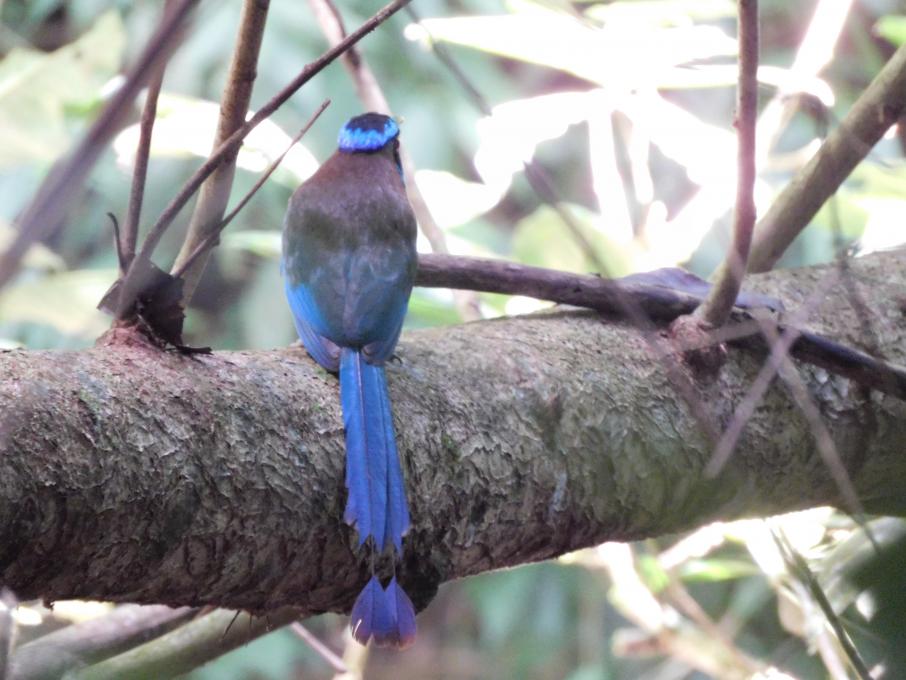 The Motmot is between the size of a sparrow and the size of a crow; it is around a foot tall. It has distinctive blue tail feathers, which end with feathers that seem almost separated from the actual tail feathers. We saw the Motmot in Carara National Park in Puntarenas, Costa Rica.
The Motmot is between the size of a sparrow and the size of a crow; it is around a foot tall. It has distinctive blue tail feathers, which end with feathers that seem almost separated from the actual tail feathers. We saw the Motmot in Carara National Park in Puntarenas, Costa Rica. 
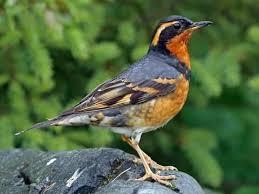

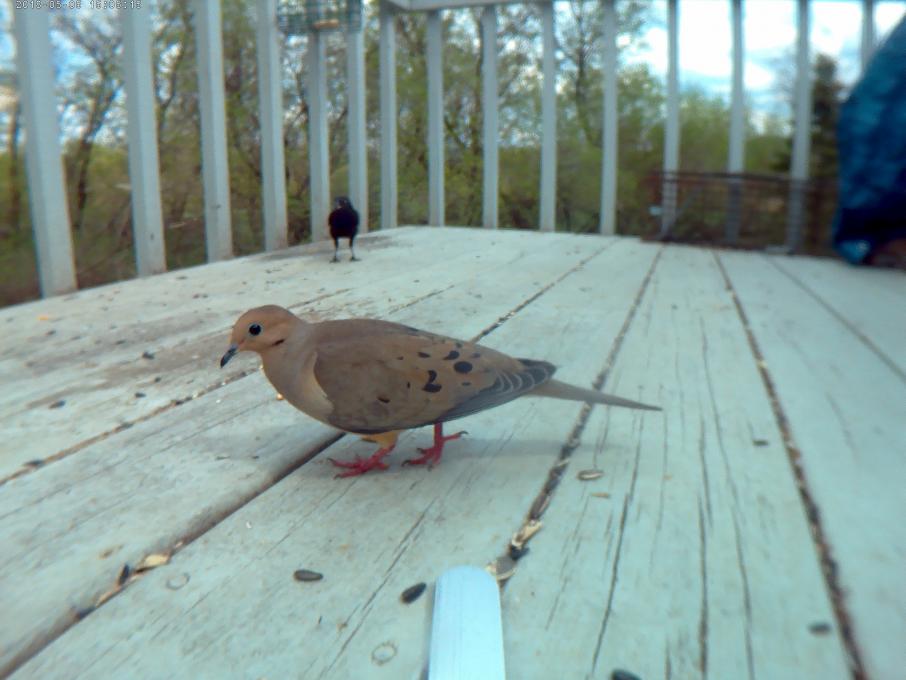 I want to give a shout out to one of my favorites, the mourning dove. They are just so chill! Love to watch them strut around our deck gobbling up the millet and such that other birds drop from our hopper feeder. Or they'll just sit on the rail taking in all the flurry of action at the feeders. Nothing fazes them (except maybe another mourning dove that tries to grab their seed). And then they'll go back to the woods and start cooing away. Love their round gray medium sized bodies with the black spots (including the big round dark eyes), their big feet and stubby little legs.
Btw, CLO has a neat online page called "What Bird are you Most Like" https://cornelllabpgstore.com/what-bird-are-you-most-like-all-outcomes/. I was a great horned owl and my wife was the mourning dove, so there you go!
Very much enjoying the course that my son (with two degrees from Cornell!) got me for my birthday.
I want to give a shout out to one of my favorites, the mourning dove. They are just so chill! Love to watch them strut around our deck gobbling up the millet and such that other birds drop from our hopper feeder. Or they'll just sit on the rail taking in all the flurry of action at the feeders. Nothing fazes them (except maybe another mourning dove that tries to grab their seed). And then they'll go back to the woods and start cooing away. Love their round gray medium sized bodies with the black spots (including the big round dark eyes), their big feet and stubby little legs.
Btw, CLO has a neat online page called "What Bird are you Most Like" https://cornelllabpgstore.com/what-bird-are-you-most-like-all-outcomes/. I was a great horned owl and my wife was the mourning dove, so there you go!
Very much enjoying the course that my son (with two degrees from Cornell!) got me for my birthday. 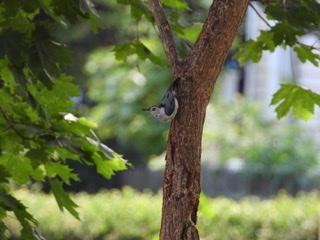
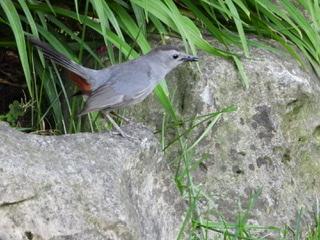
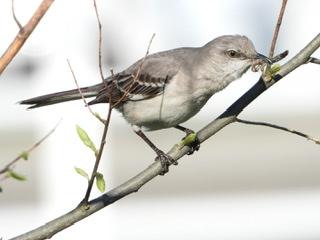 Activity 2. 1 is a white-breasted nuthatch, 2. Catbird. 3. Mockingbird
Activity 2. 1 is a white-breasted nuthatch, 2. Catbird. 3. Mockingbird 
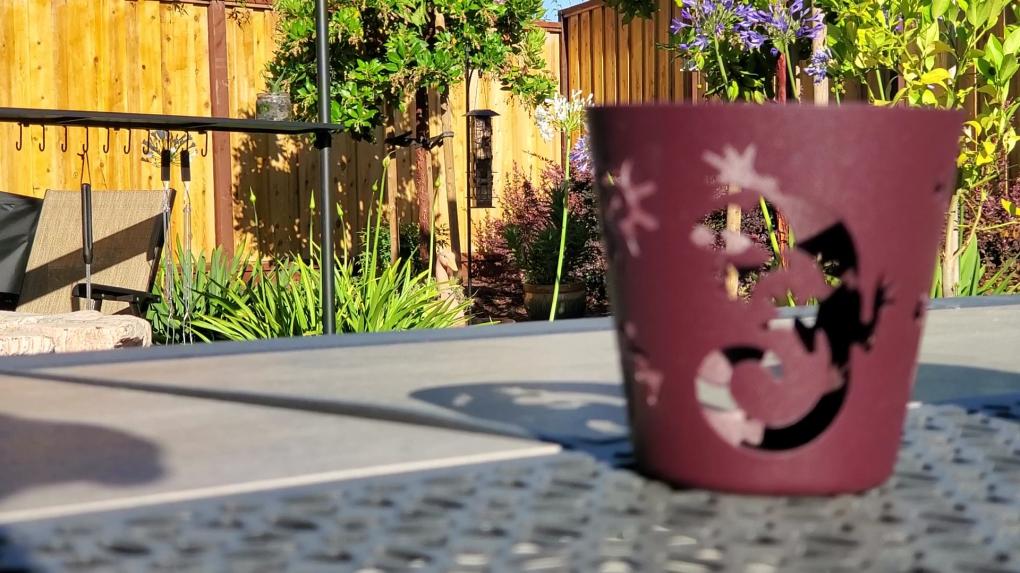
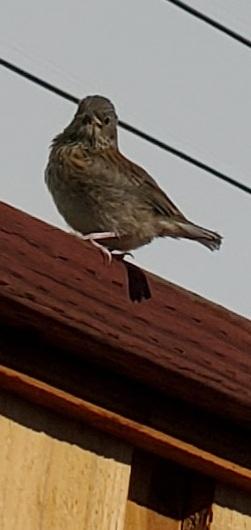 Hello
I recently noticed a lot of birds of this sort in my backyard.
Before getting the bird app and joining this course, I had gone to my hardware store and picked up a bird feeder. I already have a fountain and enjoyed seeing this little guys come around.
This is the only pic so far, I feed enjoy watching all of them.
I am mostly seeing:
Anna's hummingbird
American Crow
House Sparrow
House Finch
Pigeons
And I I believe the Bushtit as well.
Thank you for your work. I am enjoying learning more about birds and their lives.
Tim
Hello
I recently noticed a lot of birds of this sort in my backyard.
Before getting the bird app and joining this course, I had gone to my hardware store and picked up a bird feeder. I already have a fountain and enjoyed seeing this little guys come around.
This is the only pic so far, I feed enjoy watching all of them.
I am mostly seeing:
Anna's hummingbird
American Crow
House Sparrow
House Finch
Pigeons
And I I believe the Bushtit as well.
Thank you for your work. I am enjoying learning more about birds and their lives.
Tim  But this summer day we noticed a different wood pecker who flitted about in the taller bare tree trunks. It seems most wood peckers are black and white with some red on their heads. How can we tell them apart? She searched with her binoculars and I hunted in my bird book. Although I know there are many hairy woodpeckers in this area all year round, this one had a black bib so we concluded it must be the yellow bellied sap sucker who is my summer visitor. But he left before I could get a picture.
But this summer day we noticed a different wood pecker who flitted about in the taller bare tree trunks. It seems most wood peckers are black and white with some red on their heads. How can we tell them apart? She searched with her binoculars and I hunted in my bird book. Although I know there are many hairy woodpeckers in this area all year round, this one had a black bib so we concluded it must be the yellow bellied sap sucker who is my summer visitor. But he left before I could get a picture.  Here is a gold finch at our upcycled bird feeder we mainly get song sparrows at this feeder and I love their little stripey/specled pattern of their feathers. We also get a lot of cardinals and American robins in our back yard and the occasional common grackle. Also squires and chipmunks love the seeds that fall out of the feeder. For the bird differentiating activity from a distance the male grackle and crow have similar colours but the grackle is smaller and in the sun the male grackle’s head is iridescent with beautiful blue green colour. We have also identified a downy woodpecker in the near by forest and it has similar coloration as the hairy woodpecker.
for my favourite bird in the back yard I would go with “the loud one” as my 3 year old calls him. A male cardinal with beautiful red feathers with a rear of red feathers black markings on his face and bright orange beak that is quite short and thick looking perfect for breaking into seeds which he adores to eat at our feeders. He loves purching on the top of trees Singing his loud distinctive song (this his name) he is occasionally seen accompanied by a female who has a paler more orange colour and the distinctive crest.
Here is a gold finch at our upcycled bird feeder we mainly get song sparrows at this feeder and I love their little stripey/specled pattern of their feathers. We also get a lot of cardinals and American robins in our back yard and the occasional common grackle. Also squires and chipmunks love the seeds that fall out of the feeder. For the bird differentiating activity from a distance the male grackle and crow have similar colours but the grackle is smaller and in the sun the male grackle’s head is iridescent with beautiful blue green colour. We have also identified a downy woodpecker in the near by forest and it has similar coloration as the hairy woodpecker.
for my favourite bird in the back yard I would go with “the loud one” as my 3 year old calls him. A male cardinal with beautiful red feathers with a rear of red feathers black markings on his face and bright orange beak that is quite short and thick looking perfect for breaking into seeds which he adores to eat at our feeders. He loves purching on the top of trees Singing his loud distinctive song (this his name) he is occasionally seen accompanied by a female who has a paler more orange colour and the distinctive crest. 